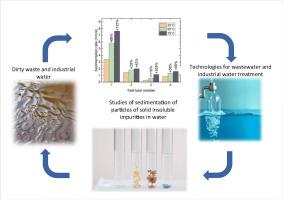水悬浮液中固体不溶性杂质颗粒的运动特征
IF 4.6
2区 工程技术
Q2 ENGINEERING, CHEMICAL
引用次数: 0
摘要
水中的固体不溶性杂质代表了一组不均匀的机械污染物,它们以各种来源、大小和化学成分的悬浮液或胶体颗粒的形式存在。它们的存在显著影响水的感官特性,也可能在工艺过程中引起并发症。本文介绍了固体不溶性杂质颗粒(活性和非活性金属及其氧化物、碳质颗粒、矿物成分、塑料和其他杂质)在沉淀和浮选条件下在水悬浮液中的行为的实验研究结果。实验结果的推广使得利用无量纲配合物预测污染水层中杂质的潜在浓度范围成为可能。在多种杂质存在的情况下,确定了颗粒沉降和浮选的集体效应。从实验数据导出的数学表达式能够预测关键输入参数(性质、大小和杂质浓度)对沉降和浮选特性的影响,从而显著改变污染废水和工艺水层的结构。实验得到的表达式可用于优化净化工艺,更准确地预测不同条件下的杂质去除效率。本文章由计算机程序翻译,如有差异,请以英文原文为准。

Movement Features of Particles of Solid Insoluble Impurities in Aqueous Suspensions
Solid insoluble impurities in water represent a heterogeneous group of mechanical contaminants present in the form of suspensions or colloidal particles of various origins, sizes, and chemical compositions. Their presence significantly affects the organoleptic properties of water and may also cause complications in technological processes. This paper presents the results of experimental studies on the behavior of solid insoluble impurity particles (active and inactive metals, their oxides, carbonaceous particles, mineral components, plastics, and other impurities) in aqueous suspensions under sedimentation and flotation conditions. Generalization of the experimental results made it possible to predict potential concentration ranges of impurities in contaminated water layers using dimensionless complexes. Collective effects of particle sedimentation and flotation in the presence of multiple impurity types were identified. Mathematical expressions derived from the experimental data enable prediction of the influence of key input parameters (properties, sizes, and concentrations of impurities) on sedimentation and flotation characteristics, which significantly modify the structure of contaminated wastewater and technological water layers. The expressions obtained from the experiments can be applied to optimize purification processes, providing more accurate forecasts of impurity removal efficiency under varying conditions.
求助全文
通过发布文献求助,成功后即可免费获取论文全文。
去求助
来源期刊

Powder Technology
工程技术-工程:化工
CiteScore
9.90
自引率
15.40%
发文量
1047
审稿时长
46 days
期刊介绍:
Powder Technology is an International Journal on the Science and Technology of Wet and Dry Particulate Systems. Powder Technology publishes papers on all aspects of the formation of particles and their characterisation and on the study of systems containing particulate solids. No limitation is imposed on the size of the particles, which may range from nanometre scale, as in pigments or aerosols, to that of mined or quarried materials. The following list of topics is not intended to be comprehensive, but rather to indicate typical subjects which fall within the scope of the journal's interests:
Formation and synthesis of particles by precipitation and other methods.
Modification of particles by agglomeration, coating, comminution and attrition.
Characterisation of the size, shape, surface area, pore structure and strength of particles and agglomerates (including the origins and effects of inter particle forces).
Packing, failure, flow and permeability of assemblies of particles.
Particle-particle interactions and suspension rheology.
Handling and processing operations such as slurry flow, fluidization, pneumatic conveying.
Interactions between particles and their environment, including delivery of particulate products to the body.
Applications of particle technology in production of pharmaceuticals, chemicals, foods, pigments, structural, and functional materials and in environmental and energy related matters.
For materials-oriented contributions we are looking for articles revealing the effect of particle/powder characteristics (size, morphology and composition, in that order) on material performance or functionality and, ideally, comparison to any industrial standard.
 求助内容:
求助内容: 应助结果提醒方式:
应助结果提醒方式:


